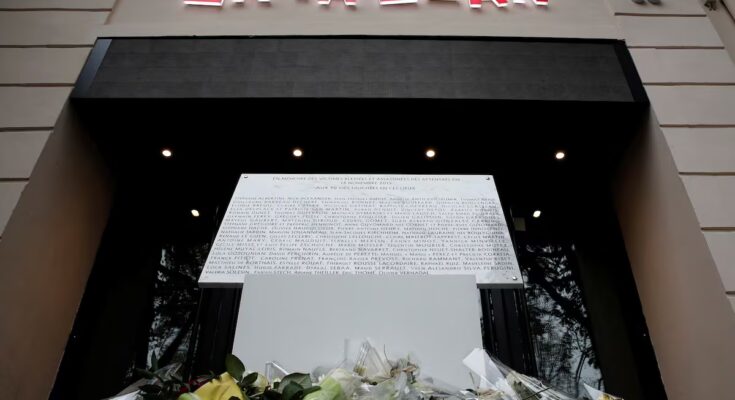It’s six in the afternoon, an hour left until the start of the concert by Orbit Culture, a Swedish group. deadly metaland the line at Bataclan almost goes around the block. There are groups of friends, singles and even a couple of couples with children. Ten years after the largest terrorist attack ever experienced in France, which caused 130 deaths, of which 90 were inside the room, there is no longer fear in the Bataclan line. As Theo, who is a regular concert-goer and has continued to go to concerts despite the trauma following the attacks, explains: “Not having returned is allowing fear to triumph and them to win.”
The historic Bataclan hall has become the symbol of resistance to horror. The horror experienced in Paris that Friday 13 November 2015. Shortly after the start of the concert by the Eagles of Death Metal group, three jihadists broke into the hall and took the 1,500 participants hostage. During the assault, which lasted three hours, they executed 90 people.
The hall was closed for a year, during which renovation work was carried out, the flooring and seating were changed and it was repainted. On September 13, 2016 it reopened with a Sting concert. Subsequently, other artists such as Pete Doherty or Marianne Faithfull passed through the hall to boost it and attract a still fearful audience.
The reconstruction was not easy, Bataclan went through financial problems and it was difficult for it to get back into business: since it was making a loss, in 2018 the former owners, Jules Frutos and Olivier Poubelle, decided to sell their share to the Lagardère group. Some proposed that it be turned into a mausoleum and closed as a concert hall. Added to this is the covid crisis, which forced the room to close again.
It was inaugurated in 1865, then called Ba-Ta-Clan, it changed owners several times and was on the verge of bankruptcy. Joël Laloux, its owner from 1976 to 2015, sold it a few months before the terrorist attacks. In 2021 the hall changed hands again and the City of Paris purchased it from the Lagardère group for 1.4 million euros. “In addition to the symbolic load that the space has for Paris, after the attacks, we are interested from an industrial and cultural point of view”, justified Emmanuel Gregoire, vice mayor, Anne Hidalgo.
The wounds left open after the attacks have reconfigured the block, where several commercial activities have changed. The Bataclan bar, right next door, has a different name today. On the corner, a flower shop has replaced the tattoo shop that was there then, and in the alley where some of the hostages managed to escape by hanging from the ledge there was a school, which has closed: “I guess they didn’t want to stay here,” explains Alain, who works at the production company that now occupies that space.
That November 13, in a chain of synchronized attacks that began at 9:20 p.m. on Friday and lasted until dawn, three nine-man commandos attacked, in addition to the concert hall, the terraces of several bars and restaurants in the 10th and 11th arrondissements of Paris. In the latter 39 people died.
A dozen people died at the Carrillon while having a drink on the terrace. Hassan says that when the bar reopened two months later, “I thought no one would want to sit on the terraces, so it was very exciting to see how people came back and sat outside, without fear. We even gave a concert, as a tribute, it was something very special,” explains this waiter, the only one who still works in this place, after the others left.
He left Le Carrillon that evening at nine o’clock. His shift was over, he greeted the customers and exchanged a few words with the colleagues who took over from him. He returned home and after exactly 19 minutes (he remembers the precise time) his wife called him in the throes of a nervous breakdown. He had just heard that several men had set up the terraces of Le Carrillon and Le Petit Cambogde, the bar just opposite.
“13 people died here on November 13th and we reopened on January 13th. The bar opened in 1913,” explains the French-Algerian behind the counter. He has been working in this place for 20 years. His face darkens, because even then he was one of the oldest waiters and knew many victims and their families. “It’s one thing to be able to talk about it, it’s another thing to have experienced it,” he says.
Some of these places have undergone a makeover, such as Le Petit Cambodge, just opposite. The terraces today are full of people and also of fences, planned for the tribute events that will take place this Thursday in each of the sites of the massacre. For days people have been going to the Place de la République to lay flowers, candles and cards in memory of those who died that night that marked Paris forever. Among the most read ones there is: “Meme pas peur” (without fear) or “Je suis Paris“(I am Paris).
The Bataclan hall celebrates its 160th anniversary this year. Next to the door there is a discreet plaque that reminds us that the room resists despite everything, but does not forget the victims. Anne, in line to see Orbit Culture, says that some of her friends died that night. She’s back. Like Theo, who summarizes: “Today, with this full room, Paris shows that it does not give in to terror, that we win”.



